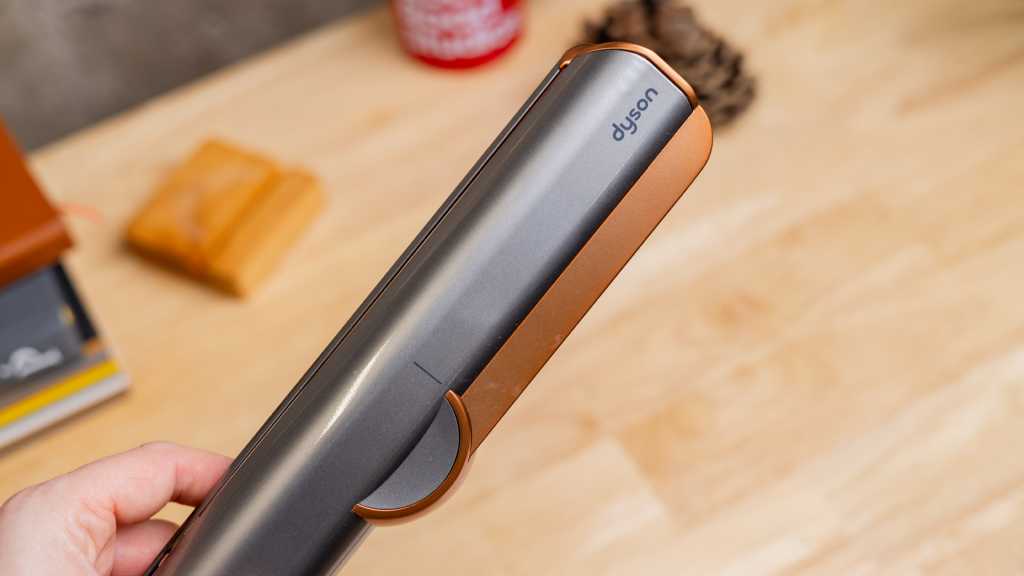Expert’s Rating
Pros
- Luxurious design
- Speedy straight styling
- Adds shine to hair
- Less damaging than classic flat irons
Cons
- Very pricey
- Big and heavy
- Limited styling options
Our Verdict
The Dyson Airstrait cuts down on the time to dry and straighten your hair, but it’s extremely expensive and not the best styling tool for travelling.
Price When Reviewed
$499.99
Best Prices Today: Dyson Airstrait
Once synonymous with vacuums, Dyson has now become the gold standard in the hair styling tool industry. There’s the legendary Supersonic hairdryer, the cordless Corrale straightener and the iconic multi-styling Airwrap, known for its salon-standard results.
But if a blowdry isn’t your thing and you’re more interested in poker straight hair and quick results, the Dyson Airstrait could be the product for you. But like all beauty gadgets from the brand, it doesn’t come cheap.
Design & Build
The Airstrait follows the same design formula that you’ll find on other products: luxurious yet chunky.
Outwardly, it looks very similar to the classic Corrale, but the plates are larger. This is because they contain vents which blow hot air on your locks, rather than the classic metal plates that heat up.
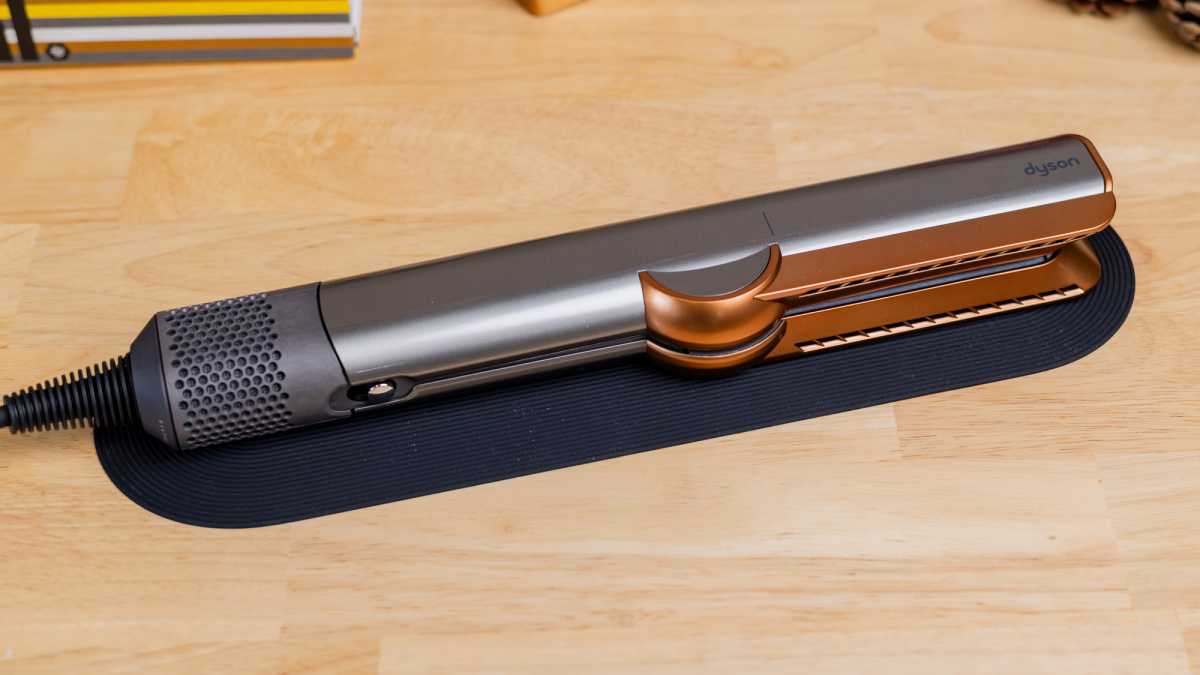
Dominik Tomaszewski / Foundry
The Dyson Airstrait measures 60 (H) x 330 (L) x 41 (W)mm and weighs 0.935 kg without the plug. The 360-swivel cord measures 198cm, and no cordless option is available. It’s heftier than the Corrale, which is already considered to be bulky.
You can get this device in Bright Nickel / Bright Copper (the version we tested) and Prussian Blue / Rich Copper in the UK. If you’re in America, you can get both these colourways, as well as a bonus Ceramic Pink Rose Gold version – perfect if you’re still in your Barbie era.
Unlike the Airwrap, no case is included as standard, but it does come with a slim heatproof mat. There’s also no travel pouch with purchase, either.
The plates can be unlocked via a toggle on the rear of the straighteners. On the front, there are five buttons: one for power, one for alternating between wet and dry modes, a cool shot button, one for changing the airflow speed and one for the overall temperature.
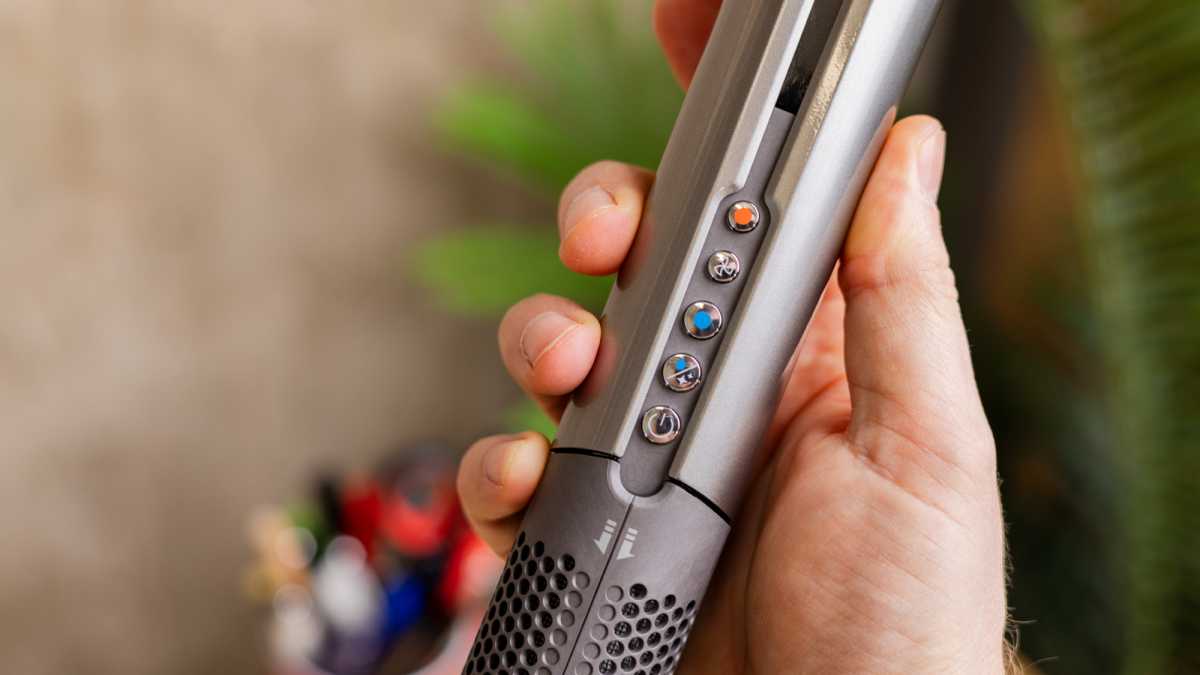
Dominik Tomaszewski / Foundry
There’s an LED screen which tells you which setting you’ve triggered, and what the tool is doing. For example, every time you boot up the Airstrait, it automatically cleans itself and will indicate this on the display.
If you keep the Airstrait still for 3 seconds, it will automatically pause. As soon as you move it, the airflow will restart. It also produces a quieter, lower airflow when you’re not pressing the plates together in unlocked mode.
Inside the arms are glass bead thermistors, which regulate airflow up to 16 times per second, ensuring your hair is safe from heat damage and allegedly providing more shine to your locks. Airflow is controlled by Dyson’s Hyperdymium motor, with a 13-blade impeller that propels 11.9 litres of air through the machine per second.
The noise of the motor is quite like the levels produced by the Airwrap – quieter than a traditional dryer, and quick to shut off when triggered.
Heat-wise, the straighteners have the option of 80°C (175°F), 110°C (230°F), and 140°C (285°F) in Wet mode, and 120°C (250°F) or 140°C (285°F), or a top-up “boost” in Dry mode. Dyson doesn’t provide a temperature for the Boost mode on its website, but Allure reports this is around 160°C/320°F.
Considering that many straighteners go up to around 230°C, that’s a lot less heat damage to your hair.
The Airstrait features a PRCD plug (Portable Residual Current Device), which can be used to test an electrical current for safety before using – something that’s recommended when your device is in proximity to water or vapour, according to Dyson.
While this is useful from a safety perspective, it adds more bulk to the straightener, which is not great for travelling, especially if you’re packing it away in a small overnight bag. Dyson also states that this plug is specific to the country you buy it in, and to refer to the manual if you’re planning on using it abroad.
At the bottom there’s a removable filter, and the straightener will notify you if this needs cleaning.

Dominik Tomaszewski / Foundry
Performance & Styling
Using the Dyson Airstrait is easy like a Sunday morning. In short, if you’ve used a pair of straighteners before, then you can use these.
Using the Dyson Airstrait on wet hair
If you’re drying and styling from wet, ensure that your locks are towel-dried first and that you’ve suitably detangled any nasty, lurking knots. You can also add products at this stage. I recommend heat protection – though the Airstrait is kinder than a traditional flat iron, it’s still better for the health of your hair.
First, you’ll want to dry your roots. This can be done by locking the plates together and turning on the Airstrait, and it will keep a continuous airflow that you can point toward the crown of your head to ensure that it’s dry before straightening.

Hannah Cowton / Foundry
I’d recommend spending more time on this than you think – sometimes I made the mistake of thinking my roots were ready, only to realise later that they needed more time. This can be annoying as the Airstrait isn’t the most comfortable to use for long periods due to its weight… but consider it your arm workout for the day.
I followed the instructions in the Dyson app, ensuring that I blasted my roots first before sectioning my hair, and pulling through sections slowly and with precision, with the vent pointing downwards.
I had to do several pull-throughs with sections to get them fully dry, but the process took just over 15 minutes in total, which is way less time than it would take me with a classic hair dryer and flat iron combo.
Here are the before and after shots:


My hair was smooth and had some shine, but despite multiple pass-throughs, there were still some annoying fly-aways in there (which may be more obvious on my all-flaws-showing OnePlus 12 camera than to the naked eye). These errant strands can be tamed by smoothing creams, shampoos and conditioners.
For reference, I have thick, type 2a hair that reaches my lower back. Typically, my hair both dries and straightens relatively easily. If you have curls or coils, then your experience may be more challenging. Equally, if your hair is super fine and shorter, the process may be a lot quicker.
Using the Dyson Airstrait on dry hair
Using the Airstrait on dry hair is equally impressive, but I will say that the low airflow speeds and cooler temperatures didn’t make a dent on my unruly mop. Of course, my experience with other hair tools had already taught me that lesson before.
As for longevity, the Airstrait isn’t quite a miracle worker. Here’s how my hair looked after using it on dry hair in the evening, and the results the morning after an eight-hour trip to the land of nod:
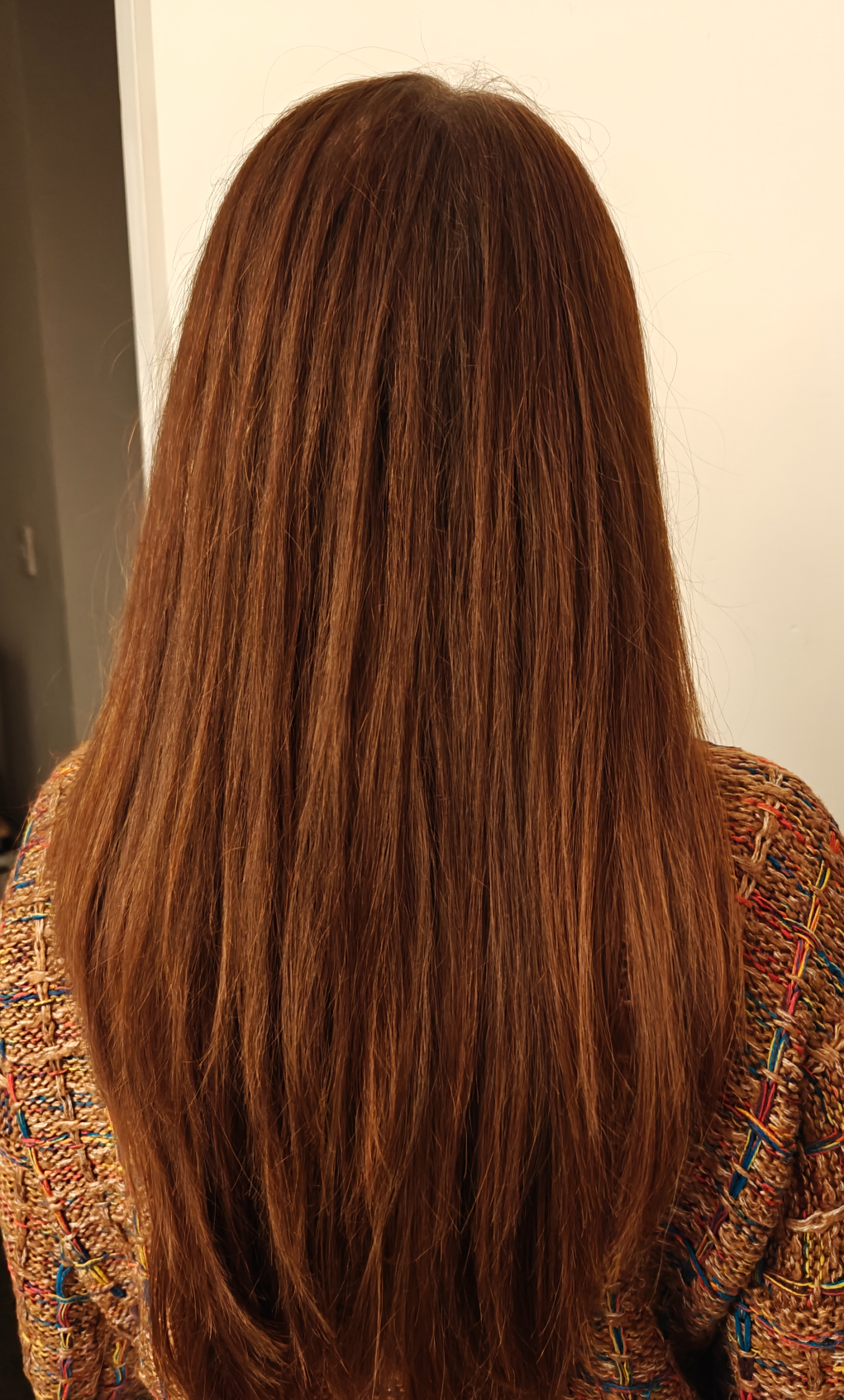
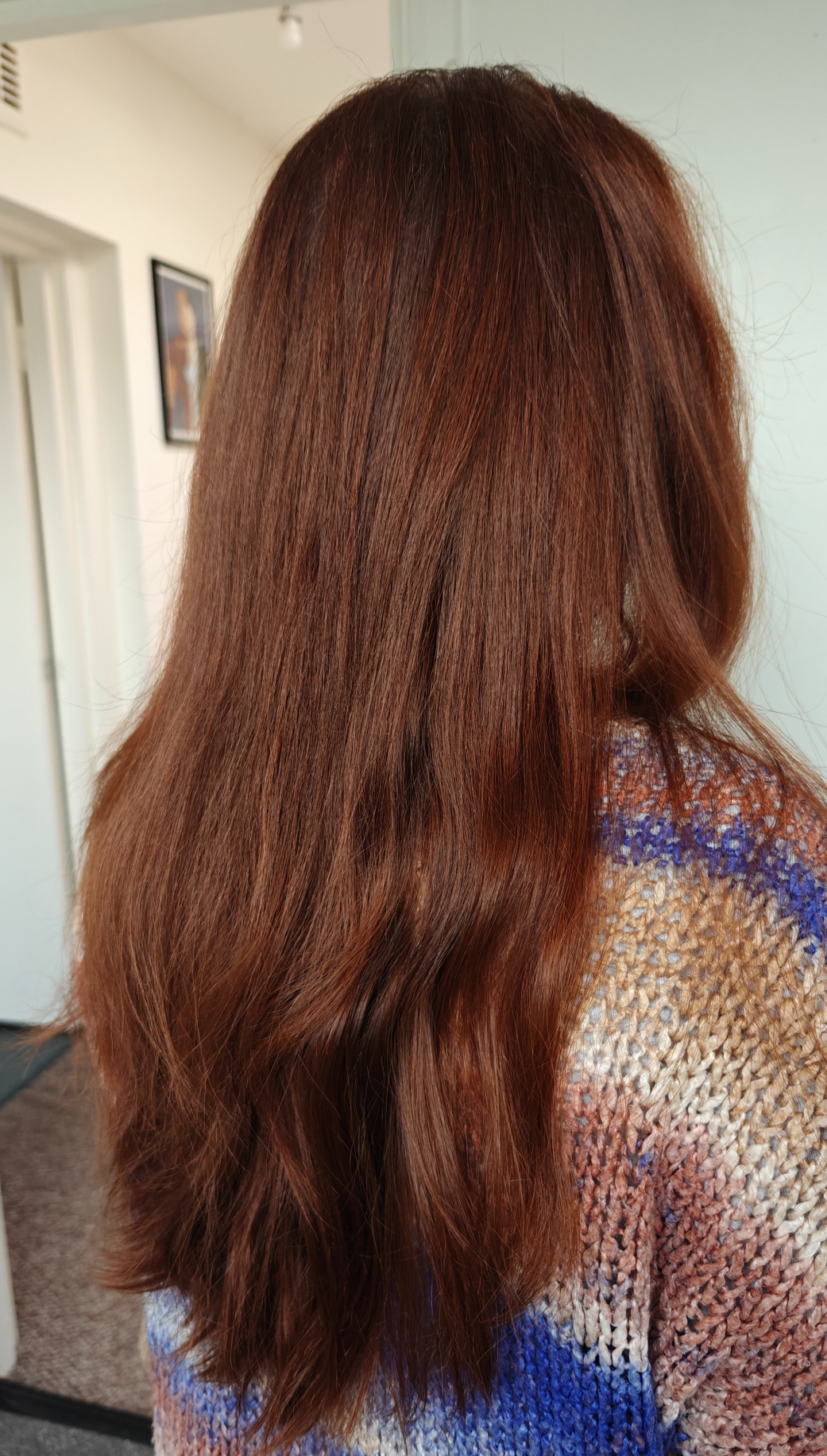
Sleeping on the hair brought out some of the natural kinks and waves, especially on the ends of my layers. In short, unless you have hair that holds styles for a long time, you probably won’t be looking at multiple days of poker straight finishes. Of course, using silk scrunchies, pillowcases or bonnets may help achieve more lasting results.
Dyson Airstrait Vs traditional flat iron
For my next rigorous test, I used the Airstrait on one side of my head (left in the picture), and a traditional straightener from Nicky Clark on the other (right in the picture). I used both tools on dry hair, with a pump of Vo5 Frizz Free Hair Cream and a smidge of Pantene Pro-V Argan Infused Hair Oil for more impressive results.
I spent five minutes total on each side, the time I’d normally spend on my hair as I’m typically rushing out the door, late for some lame reason or another.
Now time for a game of spot the difference…

Hair straightened with Dyson Airstrait (left) and Nicky Clark Infrared Pro (right)
Hannah Cowton / Foundry
There’s no doubt that both straighteners have got rid of any kinks or bulkiness on my head. However, the Dyson has a slight edge on the ends, with that glossy sheen showing up nicely. There are also slightly fewer flyaways on the top of my head on this side compared to one used with a traditional flat iron.
Later in the day, I went to a barre class, where I threw my hair into a ponytail – it also got slightly wet in the rain when I struggled to get my umbrella up. This time, the Nicky Clark side of my head won the test, with fewer waves and frizz than the Dyson side.

Post-exercise: Hair straightened with Dyson Airstrait (left) and Nicky Clark Infrared Pro (right)
Hannah Cowton / Foundry
Longevity is also an issue I found with the Airwrap, and I think it simply comes down to the products being less hot and damaging. So, while short-term styles won’t last as long, your hair should be healthier over time.
As someone who has used the Airwrap consistently over a long period, I’ve seen a lot of hair growth, so the same should apply to the Airstrait. On the other hand, when I used straighteners in the past I suffered much more breakage.
Can the Dyson Airstrait curl hair?
The clue is in the name here, as the Dyson Airstrait is not designed for curling. That said, after some real digging on TikTok, I found out it’s not completely impossible if you dare to dream.
If you try to curl in the traditional bending motion as you would with a straightener, then the vents will end up blowing your hair skywards, leaving you with a bit of a frazzled look. After a few tries, I managed to get some slight waves in the front of my hair, but nothing impressive whatsoever, with the ends not looking super healthy:

Hannah Cowton / Foundry
In the app, Dyson recommends rolling and pinning your hair after straightening certain sections to get a ‘90s blowout’. This test was a complete failure, leaving me with a Hagrid chic finish. It may just require some practice.
The best way to get curls or waves is to invest in a round brush and use the Airstrait with the plates locked together, like a traditional dryer. Wrap sections around the brush, and use the tool to blow hot hair on it – just like a traditional curly blow-dry at a salon.
My amateur attempt is below, but you can see better results over on silmarie90’s TikTok page:

Curly blowdry
Hannah Cowton / Foundry
I won’t lie, this was a bit of a faff – I had one moment where I thought I’d have to call an ambulance as the brush seemed to get stuck to my head. But, with some perseverance, I got some bounce and movement… along with a lot of static and not as impressive results as other tools.
To put it simply, if you’re after a hot air tool that can do more than straighten, then I’d advise looking at the Dyson Airwrap instead.
Price & Availability – Is the Dyson Airstrait worth the cost?
Now the part you’ve probably all been dreading: the…
